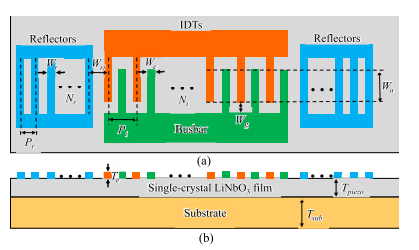This work demonstrates a group of shear horizontal (SH0) mode resonators and filters using lithium niobate (LiNbO3) thin fifilms on silicon carbide (SiC). The single-crystalline X-cut LiNbO3 thin films on 4H-SiC substrates have been prepared by ion-slicing and wafer-bonding processes. The fabricated resonator has demonstrated a large effective electromechanical coupling (k2 ) of 26.9% and a high-quality factor (Bode- Q) of 1228, hence resulting in a high figure of merit (FoM = k2 · Bode- Q) of 330 at 2.28 GHz. Additionally, these fabricated resonators show scalable resonances from 1.61 to 3.05 GHz and impedance ratios between 53.2 and 74.7 dB. Filters based on demonstrated resonators have been demonstrated at 2.16 and 2.29 GHz with sharp roll-off and spurious-free responses over a wide frequency range. The filter with a center frequency of 2.29 GHz shows a 3-dB fractional bandwidth of 9.9%, an insertion loss of 1.38 dB, an out-of-band rejection of 41.6 dB, and a footprint of 0.75 mm2. Besides, the fabricated filters also show a temperature coefficient of frequency of −48.2 ppm/◦C and power handling of 25 dBm. Although the power handling is limited by arc discharge and migration-induced damage of the interdigital electrodes and some ripples in insertion loss and group delay responses are still present due to the transverse spurious modes, the demonstrations still show that acoustic devices on the LiNbO3-on-SiC platform have great potential for radio-frequency applications.
For unreleased devices, Si substrates are also typically chosen so far as they are low cost and can support confined propagation of SAW predominantly in LiNbO3 due to the sharp contrast of material properties between Si and LiNbO3 and their implied dispersions. Record high performance has been reported as a result of the optimal exploitation of such a material stack. To further advance the performance while taking a similar material-driven approach, it is natural to pose the question if Si is the best substrate available for engineering such devices; if not, then what material is better and what modes it can support confifined propagation. Without considering the cost and the availability of the substrate, diamond is the best material . However, for implementing deployable devices, diamond might be slightly out of reach although future development on diamond thin film synthesis on Si might help to reduce the cost and widen the access. Excluding diamond, the next best material is silicon carbide (SiC) as it has a desirable mix of properties with respect to LiNbO3. The large phase velocities for the longitudinal (12 500 m/s) and shear waves (7100 m/s), the exceptionally high thermal conductivity [370 W/(m·K)], the Si-comparable but much lower than LiNbO3 dielectric constant, and the great f·Q product all promise great device performance and possibly a new type of devices for harsh environment applications for which SiC is also known.
To explore the potential of the LiNbO3 on 4H-SiC Platform, this work designs and demonstrates the first class of high-performance RF acoustic resonators and filters on such a platform prepared by ion-slicing and wafer-bonding processes. The fabricated resonators with effective electromechanical coupling coefficients greater than 20% show scalable resonances from 1.61 to 3.05 GHz, and impedance ratios between 53.2 and 74.7 dB. Filters with the same topology have been demonstrated at 2.16 and 2.29 GHz with sharp roll-off and spurious-free response over a wide frequency range. The filter with a center frequency of 2.29 GHz shows the excellent bandwidth, the good out-of-band rejection, and the decent IL. Besides, the temperature of frequency (TCF) and power handling of the fifilter have also been studied.

Fig1
The rest of this article is organized as follows. Section II offers the design of RF acoustic resonators and filters on the LiNbO3-on-SiC platform. Section III presents the fabricated LiNbO3 thin film on SiC and the SH0 resonators and filters. Section IV presents and discusses the measured results of the resonators and the filters, including the admittance responses of the resonators, S-parameters, TCF, and power handling of the filters. Finally, the conclusion is stated in Section V.
The schematic of a typical one-port SAW resonator on a heterointegrated substrate is shown in Fig. 1 with the key parameters explained in Table I. The top view of the resonator is shown in Fig. 1(a), where two grating reflectors are placed at both ends of the interdigital transducers (IDTs). The IDTs are composed of Ni pairs of metal strips aligned and connected to the busbars periodically, while the grating reflectors are composed of Nr pairs of shorted metal strips. The period Pr of the grating reflectors is generally set to half of Pi so that the resonant frequencies of the IDT and the reflectors align with each other and desired mechanical reflection can be achieved . The cross-sectional view of the resonator is shown in Fig. 1(b), where the single-crystal LiNbO3 thin film is transferred onto a substrate. Although the performance of this kind of SAW resonators will be affected by a variety of factors, such as its mode of operation, dispersion, electrode configuration, the material properties of the selected substrate, and a variety of device design details, the selected substrate plays a fundamental role in determining the mode that can be excited and confined, as well as the quality factor, electromechanical coupling, thermal and power handling of the device.
The heterogeneous integration of a single-crystalline LiNbO3 thin fifilm onto a 4H-SiC substrate is achieved by the ion-slicing process . First, a 4-in LiNbO3 wafer is implanted with helium ions (He+) at a 7◦ tilt to minimize the ion channeling effect. Then, wafer bonding is performed at 100 ℃. The bonded wafer pair subsequently underwent an annealing process so that the implanted He+ migrated to induce the exfoliation of the LiNbO3 thin film. A 4-in LiNbO3 thin fifilm with a thickness of less than 600 nm is eventually split from the bulk wafer and transferred on the SiC substrate. Finally, the rough and exfoliated surface is smoothed with inductively coupled plasma (ICP) etching.